Abstract
In this article, we propose a new transmuted modified power-generalized family of distributions constructed from the transmuted-generated and modified power-generated families. The proposed approach is flexible and provides a tradeoff between the two baseline families. For a prime study, we identify the main characteristics of the new transmuted modified power family, such as the asymptotic results, quantile function, series representation, and the various kinds of moment measures. By using the exponential distribution as the baseline, a new three-parameter lifetime distribution is constructed. The associated probability functions (density and hazard rate) are flexible and have a variety of asymmetric shapes, which make them attractive for statistical purposes. In particular, for the related probability density function, reversed-J, unimodal, and right-skewed shapes are observed. Measures relating to risk theory are also computed, such as the value at risk and the expected shortfall. By using both simulation analysis and the maximum likelihood approach, the estimation of the model parameters is evaluated. The effectiveness of the proposed model is demonstrated by two real-world cases (one in insurance and the other in reliability), and we show that it yields better fits when compared to other extended models connected to the exponential model.
Keywords:
statistical model; transmuted family; modified power distribution; estimation; actuarial measures; simulation 2010 AMS Subject Classification:
62G30; 62E10
1. Introduction
1.1. Context
In the realm of reliability analysis, the study of failure characteristics of aged machinery, tools, and gadgets has long been a topic of interest for experts. Traditionally, (probability) distributions derived from various fields have been employed to investigate these characteristics. Among the commonly used distributions were the exponential, Weibull, Kumaraswamy, Pareto, Lindley, Lomax, log-logistic, gamma, Rayleigh, log-normal, Fréchet, and Gumbel distributions. However, with the ever-increasing complexity and dynamic nature of modern datasets, these traditional distributions have proven inadequate for modeling intricate data. Recognizing this limitation, researchers have dedicated their efforts to enhancing the efficiency and applicability of these distributions, seeking better fits for diverse and evolving complex datasets encountered in practice. The literature on this subject is rich in the wide range of techniques proposed to address the challenges posed by complex data. Numerous pioneering authors have contributed to the development of novel families of distributions designed to overcome the limitations of their predecessors. Notable examples include the skew normal-G family [1] (G stands for generated), Marshall–Olkin-G family [2], exponentiated-G family [3], Kumaraswamy-G family [4], beta-G family [5], odd log-logistic-G family [6], exponentiated-generalized-G family [7], odd Weibull-G family [8], odd generalized exponential family [9], logistic-G family [10], Topp–Leone-G family [11], weighted-G family [12], Marshall–Olkin odd Lindley-G family [13], and sin-G family [14]. These extended distributions exhibit enhanced flexibility and resilience compared with their original counterparts. For some, the inclusion of new parameters enables better capture of the nuances of complex datasets and ensures a more accurate representation of the underlying phenomena. By embracing these innovative approaches, researchers and practitioners can unlock new insights and make informed decisions in the field of reliability analysis.
1.2. Idea
In order to solve difficulties relating to financial mathematics, refs. [15,16] presented an unusual approach of adding a new parameter to an existing distribution, calling this family of distributions the quadratic transmuted-generated (QT-G) family. The transmuted-generated (T-G) family was introduced by [17]. It is defined by the following cumulative distribution function (cdf):
where denotes the cdf of a baseline continuous distribution, denotes the parameters involved, and . See [17] for the detailed functional motivations. The main idea is to have a tradeoff between the baseline, and “min” and “max” distributions of two independent random variables. The past works on the T-G family include the generalized T-G family [18], exponentiated T-G family [19], transmuted T-G family [20], Kumaraswamy T-G family [21], transmuted Weibull-G family [22], transmuted geometric-G family [23], transmuted Topp–Leone G family [24], etc.
On the other side, in [25], the modified power-generated (MPo-G) family was introduced and defined by the following cdf:
where (if not, the cdf is not valid). It can be presented as a valuable generalization of the baseline distribution (obtained with ), with modulating functionalities provided by the parameter . The complete details are given in [25] (Section 2.1).
In this article, based on the above findings, a hybrid approach is considered: we propose to use the parametric scheme of the MPo-G family to increase the modeling capabilities of the T-G family. More concretely, we develop the transmuted modified power-generated (TMPo-G) family defined by the following composed cdf:
always with . Taking produces the original T-G family; other values for produce new distributions that can be used for data fitting, regression modeling, and so on. The aim of this article is to study some of these applications. The motivations behind the TMPo-G family are as follows:
- This is a new and simple family that combines the functionalities of two well-recognized families.
- By setting a baseline, we are able to make the shape of the corresponding probability density function (pdf) and hazard rate function (hrf) more flexible.
- In light of the above, statistical advances are possible: in comparison to the existing models, we can achieve better and more precise fits.
To demonstrate these points in detail, we employ the exponential distribution as the baseline, with cdf and pdf given by and , with , respectively, where is a shape parameter. The TMPo-G family structure aims to greatly improve this distribution of usable features. In particular, the shapes of the corresponding pdf are right-skewed, unimodal, and reversed-J, and those of the corresponding hrf are increasing, decreasing, increasing with a long-flat phase (useful time), and an upside-down bathtub shape with a long-flat phase. We will show that the new distribution can give better fit results on data sets in reliability and insurance than a wide panel of competent extended exponential distributions. Overall, the wide-ranging applicability of the created model, coupled with its simplicity and superior performance compared with other models, cements its position as a motivating force in the realm of insurance and reliability data analysis.
1.3. Structure of the Article
The general mathematical and structural characteristics of the TMPo-G family are covered in Section 2. In Section 3, a special distribution of the family based on the exponential distribution is proposed, and its characteristics are discussed. Section 4 is devoted to its actuarial metrics. In Section 5, a simulation analysis is presented. In Section 6, two practical data sets are fitted and commented, and Section 7 closes the work with concluding remarks.
2. Presentation and Properties of the TMPo-G Family
2.1. Presentation
The mathematical properties of the TMPo-G family are investigated in this subsection. Classically, a cdf or a pdf describes a distribution for a continuous random variable. After differentiating Equation (1), the pdf of the TMPo-G family is described by
where denotes the pdf associated with the baseline cdf . Thus, the parameters that can have an effect on this pdf are symbolized by , under the condition and under the condition . It is worth noting that the pdf of the T-G family is obtained by taking , the one of the MPo-G family for , and the one of the baseline distribution for and simultaneously. The tradeoff between these top families is, thus, realized. On the other hand, the survival function (sf) and hrf of the TMPo-G family are obtained by the following transformations:
and
respectively.
Note that we can write the hrf in Equation (4) as
where is the hrf associated with the MPo-G family. In this sense, the term plays the role of a correction term for the hrf . In addition, an immediate hrf ordering property holds: for any , we have , and the reversed inequality is fulfilled for any .
Obviously, the shapes of the pdf and hrf depend on the chosen baseline distribution, and the more these shapes are different, the more the modeling properties of the corresponding distribution are attractive from a statistical viewpoint.
2.2. Asymptotics
In this part, we discuss the asymptotic behavior of the previously introduced functions. This is important for understanding their numerical capabilities at the extremities and seeing the effects of the parameters involved. Using standard limit developments, when , we obtain
With similar techniques, when , we obtain
We, thus, see the combined impact of and on the limit bounds, also depending on the choice of the baseline distribution.
2.3. Quantile Function
The quantile function (qf) plays an important role in statistics: it is mainly used to generate random numbers, and quality control sampling methods, value at risk, and expected shortfall can be applied. The next result examines the qf of the proposed TMPo-G family.
Proposition 1.
The qf of the TMPo-G family is given by the following expression:
where and denotes the qf of the baseline distribution and is the principal branch of the standard Lambert function.
Proof.
Let us focus on the more technical case where and . By using Equation (1) and , we obtain
It follows from [17] (Equation (12)) that
which can be rewritten as
By the direct use of the principal branch of the standard Lambert function, we obtain
The other cases can be proved in similar and more simple manner. This ends the proof. □
The qf presented in Proposition 1 has the advantage of being manageable from a practical viewpoint. Indeed, most of the mathematical software packages have the Lambert function implemented, which facilitates its use for numerical operations. Furthermore, we can immediately express some famous quantile measures, such as the median, defined as
The first and third quartiles can be expressed in a similar manner, and the same for various quantile skewness and kurtosis measures (see [26]).
2.4. Series Representations
In distribution theory, we often use series representation to convert the pdf and cdf into a simple form, which involves baseline distribution functions. We can use this representation further to find moments, incomplete moments, etc.
In the next result, a series representation of the cdf of the TMPo-G family is suggested in terms of controllable baseline distribution functions.
Proposition 2.
The cdf of the TMPo-G family can be expanded as
Proof.
To begin, the following decomposition holds:
Using the usual exponential series expansion, we obtain
and
We immediately obtain
The desired result is obtained. □
Proposition 2 finds interest in the fact that most of the exponentiated versions of the standard baseline distributions, as well as their properties, are very well known. We, thus, aim to transpose them into our new family.
Based on Proposition 2, the pdf of the TMPo-G family can be expanded as
This result is applied to express moments of various types in the following subsection.
2.5. Moments
Let be a function and X be a random variable with the pdf of the TMPo-G family so that exists. Then, Proposition 2 gives
where
The coefficient is calculable for most of the standard baseline distributions (an example will be detailed later).
This formula can be used to calculate the mean, variance, standard deviation, coefficients of skewness and kurtosis of X, and other statistics based on the following formulas: or , where r denotes a positive integer. Thus, they are obtained by taking and . In particular, for , we can write
where
In this case, the coefficient is already evaluated in the literature for many baseline distributions, which is the main interest of such expansions.
Basically, the nature of the shapes of a distribution can be determined by the different moments it contains. The first four moments of X are as follows: The first moment is the mean of X, which indicates the central tendency of a distribution. The variance of X is represented by the second central moment, , which indicates the width or deviation. The third central moment of X is , and the fourth central moment of X is .
The moment-based skewness of X is , which indicates any asymmetric leaning to either left or right, and the moment-based kurtosis of X is , which indicates the degree of central peakedness or, equivalently, the fatness of the outer tails.
In addition, the incomplete moments can be investigated. Incomplete moments have several advantages in statistical analysis. First, they provide a way to estimate population moments using incomplete data, making them useful when dealing with missing or censored observations. Second, the incomplete moments can handle non-standard distributions and are robust to outliers, making them more versatile in modeling real-world data compared to traditional complete moments. In our context, the rth incomplete moment of X is defined by , where denotes the indicator operator. Then, Proposition 2 gives
where
Again, the main interest of such expansions is the coefficient , which has already been calculated in the literature for numerous baseline distributions.
2.6. Estimation
Here, we describe how we can estimate the parameters involved in the TMPo-G family using the maximum likelihood method. Both analytical and numerical approaches can be used to manage the normal approximation associated with the maximum likelihood estimates (MLEs). In particular, when creating confidence intervals, the MLEs provide simple approximations that perform well in finite samples and have the desired features. By taking a sample from the TMPo-G family with the observed values , the corresponding log-likelihood function of the vector parameter is
The MLEs are defined by the values of the parameters that maximize this function.
Once we have the MLEs, we have to substitute them for the parameters in the functions of the TMPo-G family to obtain efficient estimates of these functions.
On the other hand, the standard error (SE) associated to a parameter is the sampling distribution’s standard deviation or an estimate of the standard deviation of the estimator of the parameter. As a result, there is a greater likelihood that the sample estimate will be close to the outcome of equal, complete coverage. A small SE implies that the fluctuation in values around the parameter estimate from repeated samples is moderate (see [27]).
Based on the asymptotic properties of the random versions of the MLEs and their SEs, we can construct confidence intervals and statistical test procedures (see [28]).
In an alternative way, the Bayesian method also provides a flexible and powerful framework for statistical inference, allowing researchers to make probabilistic statements about unknown parameters and quantify uncertainty in a principled manner (see [29,30]). Here, we focus on the maximum likelihood approach because it is more widely used and has well-known theoretical and practical guarantees.
The rest of the study is devoted to a special member of the TMPo-G family, with the exponential distribution as the baseline distribution.
3. The TMPoE Distribution
3.1. Presentation
We now define the TMPo exponential (TMPoE) distribution by taking the exponential distribution as the baseline, with the cdf and the pdf , with and . By considering the general cdf in Equation (1), the TMPoE distribution has the following cdf:
where . Defined like this, the TMPoE distribution forms a new and simple three-parameter lifetime distribution that benefits from the combined functionalities of the T-G and MPo-G families and the exponential distribution.
It is interesting to note that, by putting , the resultant cdf will be a product of the cdf of the exponential distribution and the cdf of the Gumbel distribution (also known as the type-I generalized extreme value distribution).
The famous transmuted exponential distribution also appears by taking (see [31]).
Figure 1 and Figure 2 display some plots of the pdf and hrf of the TMPoE distribution for a set of selected parameter values. Figure 1 reveals that the TMPoE distribution is right-skewed, unimodal, and reversed-J-shaped. In addition, Figure 2 demonstrates that the corresponding hrf can produce increasing and decreasing shapes, increasing shapes with a long-flat phase (useful time), and upside-down bathtub shapes with a long-flat phase. The long useful period is important and perhaps one of the most significant phases for reliability prediction and evaluation activities, as it explains the normal lifetime of the component or system. Therefore, having a model that can adequately capture flat regions with other hrf shapes is very essential.
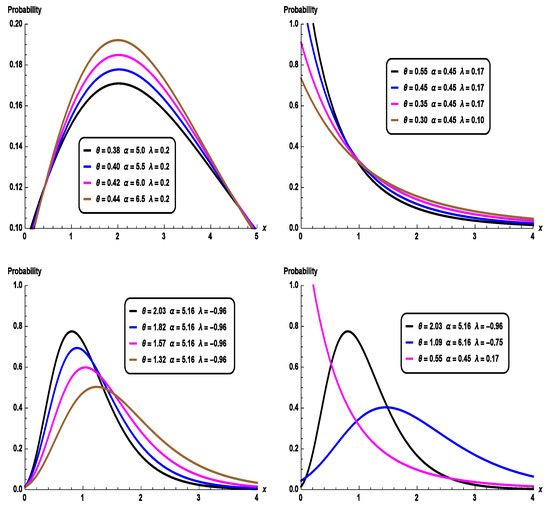
Figure 1.
Plots of the pdf of the TMPoE distribution for some parametric values.
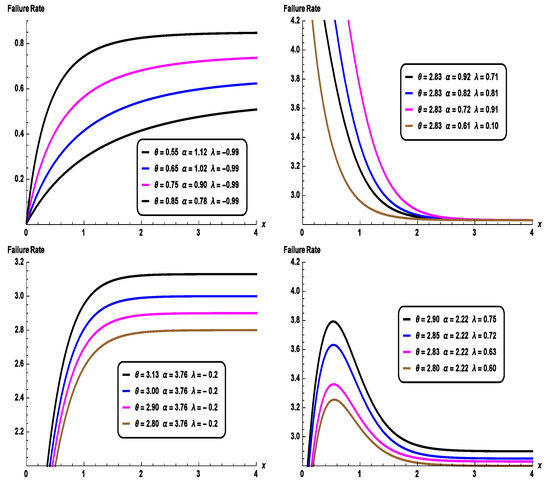
Figure 2.
Plots of the hrf of the TMPoE distribution for some parametric values.
In order to understand the limit behavior of the above functions, we can investigate their asymptotic properties. Using standard limit developments, when , we obtain
With similar techniques, when , we obtain
3.2. Expansion of the TMPoE Distribution
This section focuses on the various characteristics of the TMPoE distribution, including linear representation, quantile function, moments, moment measures, and estimation. In order to examine some characteristics of the distribution involving integral terms, we now express the pdf of the TMPoE distribution as straightforward linear exponential terms.
Proposition 3.
The pdf of the TMPoE distribution can be represented as follows:
where
and
Proof.
Based on Equation (5), we have
Since k is an integer, the standard binomial expansion gives
and the same holds with instead of k. Hence, the pdf reduces to
The proof ends. □
As for the general case, the obtained representation will provide manageable series expansions of various moment measures, which is always a plus for computational purposes.
3.3. Quantile Function
In the context of lifetime analysis, the qf is a precise statistical metric that can be used to construct artificial survival time data sets for biological case studies, calculate percentiles for time-to-failure distributions, and investigate specific risk indicators in an actuarial setting. The qf corresponding to the TMPoE distribution is examined in the next result.
Proposition 4.
The qf of the TMPoE distribution is given by
where .
Proof.
The proof immediately follows from Proposition 1 and the fact that the qf of the exponential distribution is
This completes the proof. □
The qf presented in Proposition 4 is quite manageable, as already mentioned for the general case in Proposition 1. In particular, the median of the TMPoE distribution is obtained as
In addition to diverse quantile measures, the generation of values from a random variable with the TMPoE distribution can be implemented.
3.4. Moment Measures
As already sketched, the two most popular methods for summarizing the characteristics of a lifetime distribution are the measure of central tendency and dispersion. Two commonly used metrics are expected value and variance. Moment skewness and kurtosis are other characteristics that could be condensed. These measures are investigated in this subsection for the TMPoE distribution.
The following result is dedicated to a tractable expansion of the moments of the TMPoE distribution.
Proposition 5.
Let r be a positive integer and X be a random variable with the TMPoE distribution. Then the rth moment of X exists, and it can be expanded as
Proof.
Based on the expansion in Proposition 3, we have
By changing the variable and employing the property of the standard gamma function , we obtain
The proof ends. □
For some parametric values, Table 1 displays the first four raw moments (), central moments (), coefficient of kurtosis () and (Pearson) coefficient of skewness () of a random variable X with the TMPoE distribution. The following four different scenarios of parametric values are used: S-1 = ; S-2 = ; S-3 = ; and S-4 = .

Table 1.
Measures of dispersion of the TMPoE distribution for some parametric values.
Thus, we can see how these metrics can be adjusted based on the values of the parameters. Particularly, low and high values for the kurtosis are observed, as well as positive values for the skewness. Figure 3 and Figure 4 show the plots of the mean, variance, skewness, and kurtosis associated with the TMPoE distribution for various parametric values. In particular, they emphasize the importance of the role of .
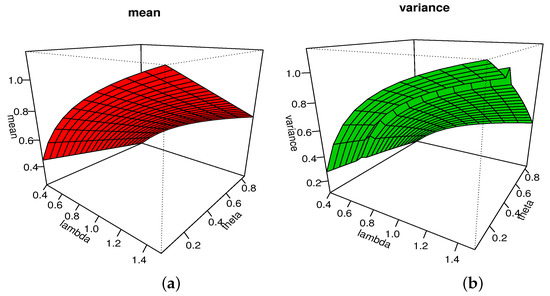
Figure 3.
Graphical illustrations of the mean (a) and variance (b) associated with the TMPoE distribution.
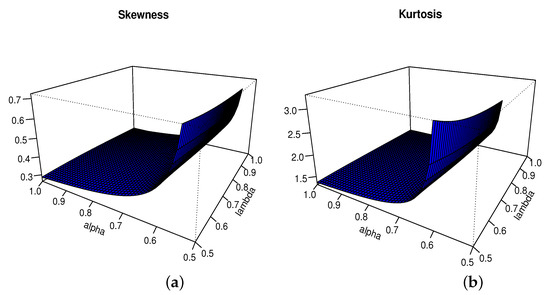
Figure 4.
Graphical illustrations of the skewness (a) and kurtosis (b) associated with the TMPoE distribution.
We end this part by the incomplete moments associated with the TMPoE distribution in the next proposition.
Proposition 6.
Let r be a positive integer, X be a random variable with the TMPoE distribution and . Then, the rth incomplete moment of X at t exists, and it can be expanded as
where is the lower incomplete gamma function.
Proof.
Based on the expansion in Proposition 3, we have
By changing the variable and employing the lower incomlete gamma function, we obtain
The proof ends. □
3.5. Estimation
The work in Section 2.6 on the maximum likelihood estimation for the general TMPo-G family can be transposed for the TMPoE distribution by considering the exponential distribution for the baseline distribution. As a result, by taking into account the observed values from the TMPoE distribution, the log-likelihood function for the vector of parameters is
The MLEs are obtained by maximizing this function with respect to . Then, based on the MLEs, we can estimate the functions depending on the parameters by substitution, calculate the related SEs, construct confidence intervals, and conduct statistical tests (see [28]).
4. Some Actuarial Measures
In this section, we discuss some important risk measures including value at risk, expected shortfall, and tail value at risk of the TMPoE distribution.
4.1. Value at Risk
The value at risk (VaR) determines an investment’s potential loss based on a specified time frame and confidence level. It plays a crucial role in many business decisions. The value of the loss portfolio is determined by a specific level of confidence, say q, with . The VaR of a given distribution is its qf, i.e., VaR = (see [32]). In the setting of the TMPoE distribution, it is given in Proposition 4.
4.2. Expected Shortfall
Another important financial risk measure is called an expected shortfall (ES) introduced by [33] and generally considered a better measure than value at risk. It is defined by the following expression:
Using Proposition 4, the ES of the TMPoE distribution can be obtained.
4.3. Numerical Illustration of VaR and ES under the TMPoE Distribution
Here, we demonstrate the visual and numerical representation of the two primary risk measurements, ES and VaR. It is feasible to compare the ES and VaR of the proposed TMPoE distribution to the exponentiated exponential Poisson (EEP) and exponentiated exponential (EE) distributions by employing the MLEs of the parameters for certain configurations. For comparison purposes, it is important to note that a distribution is said to have a heavier tail if the risk measurement has greater values.
The scale and shape parameters are executed in various combinations described as follows: I = , II = , III = , and IV = . Figure 5 shows the change in the VaR and ES curves associated with the TMPoE distribution for some parametric values.
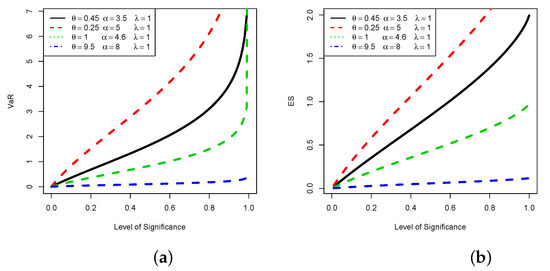
Figure 5.
Plots of the VaR (a) and ES (b) of the TMPoE distribution for some parametric values.
The ES and VaR for the TMPoE, EEP, and EE distributions are numerically illustrated in Table 2, which also shows that the TMPoE distribution has a higher value of both risk measures than the EEP and EE distributions.

Table 2.
A summary of the ES and VaR of the TMPoE distribution.
In addition, it has a slightly heavier tail than the EEP and EE distributions, according to the visual representation of the distributions in Figure 6. Ref. [34] is recommended for a detailed discussion of VaR and ES, and how they are computed using an R–Programming Language.
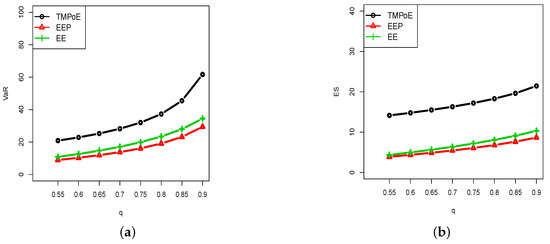
Figure 6.
Plots of the VaR (a) and ES (b) of the TMPoE, EEP, and EE distributions.
5. Simulation Analysis
Here, we develop a simulation study to look at the actions of MLEs inside the framework of the TMPoE model paradigm. The performance of the estimates over predefined replications at different sample sizes is assessed using simulation analysis, which is one of the most crucial statistical procedures. To this end, a simulation process is repeated 1000 times with different sample sizes (, 50, 100, 150, 200, and 500). The parameters , , and are combined in the following different scenarios: , , and , named Scenario-I; , , and , named Scenario-II; , , and , named Scenario-III; and , , and , named Scenario-IV. As the main benchmark measures, we recall that the bias and mean square error (MSE) are defined by
where , and is an estimate of constructed from the ith sample. We also consider the coverage probability (CP), lower bound (L.Bound) and upper bound (U.Bound) of a parameter confidence interval, and the average width (AW).
The bias, MSE, AW, CP, L.Bound, and U.Bound at various sample sizes are shown together with a thorough overview of the Monte Carlo simulation in Table 3 and Table 4.

Table 3.
Biases, MSEs, CPs, L.Bounds, U.Bounds, and AWs for different scenarios.

Table 4.
Biases, MSEs, CPs, L.Bounds, U.Bounds, and AWs for different scenarios.
The general finding of the simulation analysis yields that the estimates become stable as n becomes large, the MSE reduces as n increases, and the bias reduces as n becomes very large. Also, the AW decreases as the sample size increases. Moreover, the CP is close to the nominal level of 95%. As a result, it is possible to estimate and create confidence intervals for the suggested TMPoE model parameters using the MLEs and their asymptotic results. Readers can refer to [35] for a simple and comprehensive method of designing a Monte Carlo simulation research study using the R–programming language.
The R code used for this simulation work is given in Appendix A.
6. Practice for the TMPoE Model
Here, we present two data examples to show how the suggested TMPoE distribution is adaptable and useful.
The first data set, referred to as Data 1, examines the most prevalent grievances against automobile insurance companies during a two-year period as a percentage of their total business, including non-renewal of insurance and no fault claims. This data set was also considered in [36].
The second data set, referred to as Data 2, was taken from [19], which represents the Kevlar 373/epoxy material life of fatigue fractures.
Several modified versions of the well-known exponential models are used in the comparative analysis, including transmuted generalized exponential (TGE) model [37], gamma-exponentiated exponential (GEE) model [38], exponential (E) model, exponentiated exponential (EE) model, exponentiated Weibull (EW) model [39], odd Weibull exponential (OWE) model [8], Kumaraswamy exponential (KwE) model [40], and beta exponential (BE) model [41].
The R–programming language is used for all statistical computations. The MLEs and SEs of the estimates of the fitted models for Data 1 and Data 2 are displayed in Table 5 and Table 6.

Table 5.
Estimated parameters and SEs for Data 1 and Data 2.

Table 6.
The statistics , AIC, CAIC, BIC, HQIC, , , K-S, and p-value for Data 1 and Data 2.
Subsequently, the following statistical measures are considered: Akaike information criterion (AIC), consistent Akaike information criterion (CAIC), Bayesian information criterion (BIC) (all depending on the maximized log-likelihood function denoted as ), Hannan–Quinn information criterion (HQIC), Anderson–Darling , Cramér–von Mises statistic, and Kolmogorov–Smirnov (K-S) statistic. For the TMPoE model, we find that AIC = 637.172, CAIC = 637.455, BIC = 644.638, HQIC = 640.182, 1.451, 0.209, K-S = 0.100, and p-value = 0.313, which are the best of the other comparable models. Similarly, using the second data set provided AIC = 247.336, CAIC = 247.666, BIC = 254.325, HQIC = 250.127, 0.453, 0.076, K-S = 0.086, and p-value = 0.588. Thus, the TMPoE distribution provides a better fit than other comparable distributions.
A graphical analysis can complete these results. The probability–probability (P-P) plot can be used to assess how well our data set fits our distribution. When the two cdfs are plotted against one another, the data will resemble a virtually straight line if they are identical. In addition, the shapes of the distributions are compared using a quantiles–quantiles (Q-Q) plot, which gives a graphical representation of how characteristics, like location, scale, and skewness, are the same or different between the two distributions. Comparing sets of data or theoretical distributions can be conducted using Q-Q plots. On the other hand, the main goal of the total time on test (TTT) plot is to identify a constant hrf, an increasing hrf, or a decreasing hrf.
With a focus on TMPoE model, the Figure 7 and Figure 8 provide a graphical representation of both data sets, which include estimated pdf, estimated cdf, P-P, TTT, estimated hrf, and Q-Q plots for Data 1 and Data 2, respectively. These figures demonstrate a high correlation between the actual and projected results.
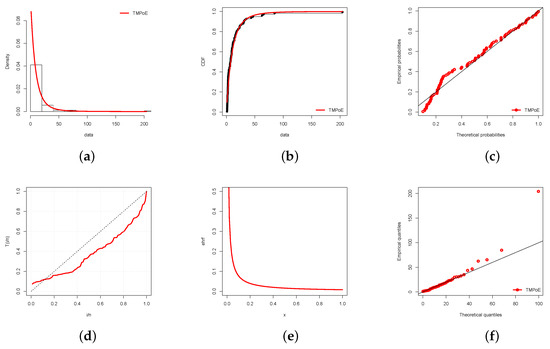
Figure 7.
Plots of the (a) estimated pdf, (b) estimated cdf, (c) P-P, (d) TTT, (e) estimated hrf, and (f) Q-Q for Data 1.
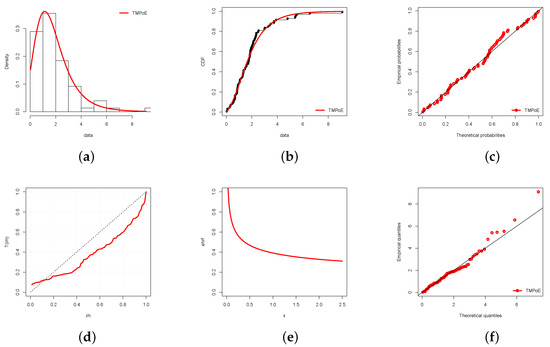
Figure 8.
Plots of (a) estimated pdf, (b) estimated cdf, (c) P-P, (d) TTT, (e) estimated hrf, and (f) Q-Q for Data 2.
On the basis of our results from the earlier statistics, it is clear that the TMPoE model performs better than a number of well-known models.
7. Concluding Remarks
We have introduced a new and flexible family of distributions, named the TMPo-G family. In a first part, we derived its main general mathematical characteristics, including the series expansion of the probability density function, and performed in-depth investigations of the quantile function, moments, incomplete moments, and parameter estimation. An exponential distribution was used as the baseline for creating the TMPoE distribution. The advantage of the TMPoE distribution is that it is flexible in the statistical modeling sense. Indeed, the shape of the corresponding pdf is right-skewed, unimodal, and reversed-J. In addition, the shape of the hrf increases with the long-flat phase (useful time) and can be upside-down bathtub with a long-flat phase. In another part, actuarial risk measures, such as expected shortfall and value at risk, were developed, along with a simulation analysis. As a result, it was shown that the TMPoE distribution has a heavier tail than the EEP and EE distributions. Then, we applied it to two real-world data sets (one in insurance and the other in reliability). During the statistical data analysis, we discovered that it outperformed some of its predecessors. Consequently, some other subdistributions of the proposed family, like the TMPo-Weibull distribution, the TMPo-Burr XII distribution, and the TMPo-Kumaraswamy distribution, can be employed, as future work, for data analysis in a specific area because of the complex and probabilistic structure of the data. Overall, the TMPoE distribution can be applied to analyze similar types of data in many different fields to enable comparisons and foster a better understanding of insurance data across different regions.
Author Contributions
Conceptualization, S.N., L.A.A.-E., H.S.B. and C.C.; methodology, S.N., L.A.A.-E., H.S.B. and C.C.; software, S.N., L.A.A.-E., H.S.B. and C.C.; validation, S.N., L.A.A.-E., H.S.B. and C.C.; formal analysis, S.N., L.A.A.-E., H.S.B. and C.C.; investigation, S.N., L.A.A.-E., H.S.B. and C.C.; data curation, S.N.; writing—original draft preparation, S.N., L.A.A.-E., H.S.B. and C.C.; writing—review and editing, S.N., L.A.A.-E., H.S.B. and C.C.; visualization, S.N.; funding acquisition, L.A.A.-E. All authors have read and agreed to the published version of the manuscript.
Funding
Princess Nourah bint Abdulrahman University Researchers Supporting Project number (PNURSP2023R443).
Data Availability Statement
The data used to support the findings of this study are in the manuscript.
Acknowledgments
Princess Nourah bint Abdulrahman University Researchers Supporting Project number (PNURSP2023R443), Princess Nourah bint Abdulrahman University, Riyadh, Saudi Arabia.
Conflicts of Interest
The authors declare that there are no conflict of interest.
Abbreviations
| List of Abbreviations | |
| Probability density function | |
| cdf | Cumulative distribution function |
| hrf | Hazard rate function |
| MPo-G | Modified power-generated |
| QT-G | Quadratic transmuted-generated |
| T-G | Transmuted-generated |
| TMPo-G | Transmuted modified power-generated |
| TMPoE | Transmuted modified power exponential |
| VaR | Value at risk |
| ES | Expected shortfall |
| MLE | Maximum likelihood estimate |
| SE | Standard error |
| MSE | Mean square error |
| CP | Coverage probabilities |
| AW | Average width |
| TGE | Transmuted generalized exponential |
| GEE | Gamma exponentiated exponential |
| E | Exponential |
| EE | Exponentiated exponential |
| EW | Exponentiated Weibull |
| OWE | Odd Weibull exponential |
| KwE | Kumaraswamy exponential |
| BE | Beta exponential |
| AIC | Akaike information criterion |
| CAIC | Consistent Akaike information criterion |
| BIC | Bayesian information criterion |
| HQIC | Hannan–Quinn information criterion |
| K-S | Kolmogorov–Smirnov |
| P-P | Probability–probability |
| Q-Q | Quantile–quantile |
| TTT | Total time on test |
| List of Symbols | |
| Baseline vector of parameters | |
| , , | Main parameters used |
| Baseline cumulative distribution function | |
| Baseline probability density function | |
| Probability density function | |
| Survival function | |
| Hazard rate function | |
| Hazard rate function | |
| M | Median |
| X | Random variable |
| rth moment | |
| rth incomplete moment at t | |
| Coefficient of moment skewness | |
| Coefficient of moment kurtosis | |
| Gamma function | |
| Lower incomplete gamma function | |
| Log-likelihood function | |
| Value at risk | |
| Expected shortfall | |
| Anderson–Darling | |
| Cramér–von Mises | |
Appendix A
R code for the simulation
- pdf_PPL <- function(par,x){
- c=par[1]
- alpha=par[2]
- delta=par[3]
- G=1-exp(-c*x)
- g=c*exp(-c*x)
- F=1-(1-delta*(G*alpha^(G-1)))*(1-G*alpha^(G-1))
- f=g*alpha^(G-1)*(1+log(alpha)*G)*(1+delta-2*delta*G*alpha^(G-1))
- return(f)
- }
- ll.PPL <- function(par){
- -sum(log(pdf_PPL(par,x)))
- }
- quantile <- function(c,alpha,delta,u){
- t=lambertW0((1/2)*(alpha*log(alpha)+((alpha*log(alpha))/delta)
- -alpha*log(alpha)*sqrt(1+2*delta-4*u*delta+delta^2)))/log(alpha)
- q1=-1/c*log(1-t)
- return(q1)
- }
- library(numDeriv)
- c=0.5;alpha=0.3;delta=1
- n1=c(25,50,100,500)
- for (j in 1:length(n1)){
- n=n1[j]
- N=500
- mle_c<- c(rep(0,N))
- mle_alpha<-c(rep(0,N))
- mle_delta<-c(rep(0,N))
- LC_c<-c(rep(0,N))
- UC_c<-c(rep(0,N))
- LC_alpha<-c(rep(0,N))
- UC_alpha<-c(rep(0,N))
- LC_delta<-c(rep(0,N))
- UC_delta<-c(rep(0,N))
- temp=1
- count_c=0;count_alpha=0;count_delta=0
- HH1<-matrix(c(rep(2,9)),nrow=3,ncol=3)
- HH2<-matrix(c(rep(2,9)),nrow=3,ncol=3)
- for (i in 1:N)
- {
- #print(i)
- #flush.console()
- repeat{
- x<-c(rep(0,n))
- #Generate a random variable from uniform distribution
- u<-0
- u<-runif(n,min=0,max=1)
- for (k in 1:n){
- x[k]<-quantile(c=c,alpha=alpha,delta=delta,u[k])
- }
- #Maximum likelihood estimation
- mle.result<-nlminb(c(c=c,alpha=alpha,delta=delta),
- ll.PPL,lower=c(0,0,0),upper=c(Inf,Inf,Inf))
- temp=mle.result$convergence
- if(temp==0){
- temp_c<-mle.result$par[1]
- temp_alpha<-mle.result$par[2]
- temp_delta<-mle.result$par[3]
- HH1<-hessian(ll.PPL,
- c(temp_c,temp_alpha,temp_delta))
- if( sum(is.nan(HH1))==0 & (diag(HH1)[1]>0) &
- (diag(HH1)[2]>0) & (diag(HH1)[3]>0) ){
- HH2<-solve(HH1)
- #print(det(HH1))
- }
- else{
- temp=1}
- }
- if ((temp==0) & (diag(HH2)[1]>0) & (diag(HH2)[2]>0)
- & (diag(HH2)[3]>0) & (sum(is.nan(HH2))==0)){
- break
- }
- else{
- temp=1}
- }
- mle_c[i]<-mle.result$par[1]
- mle_alpha[i]<-mle.result$par[2]
- mle_delta[i]<-mle.result$par[3]
- HH<-hessian(ll.PPL,c(mle_c[i],mle_alpha[i],
- mle_delta[i]))
- H<-solve(HH)
- LC_c[i]<-mle_c[i]-qnorm(0.975)*sqrt(diag(H)[1])
- UC_c[i]<-mle_c[i]+qnorm(0.975)*sqrt(diag(H)[1])
- if( (LC_c[i]<=c) & (c<=UC_c[i])){
- count_c=count_c+1
- }
- LC_alpha[i]<-mle_alpha[i]-qnorm(0.975)*sqrt(diag(H)[2])
- UC_alpha[i]<-mle_alpha[i]+qnorm(0.975)*sqrt(diag(H)[2])
- if( (LC_alpha[i]<=alpha) & (alpha<=UC_alpha[i])){
- count_alpha=count_alpha+1
- }
- LC_delta[i]<-mle_delta[i]-qnorm(0.975)*sqrt(diag(H)[3])
- UC_delta[i]<-mle_delta[i]+qnorm(0.975)*sqrt(diag(H)[3])
- if( (LC_delta[i]<=delta) & (delta<=UC_delta[i])){
- count_delta=count_delta+1
- }
- }
- #Calculate Average Bias
- ABias_c<-sum(mle_c-c)/N
- ABias_alpha<-sum(mle_alpha-alpha)/N
- ABias_delta<-sum(mle_delta-delta)/N
- #print(cbind(ABias_c,ABias_alpha,ABias_delta))
- #Calculate MSE
- MSE_c<-sum((c-mle_c)^2)/N
- MSE_alpha<-sum((alpha-mle_alpha)^2)/N
- MSE_delta<-sum((delta-mle_delta)^2)/N
- #print(cbind(RMSE_c,RMSE_alpha,RMSE_delta))
- #Converge Probability
- CP_c<-count_c/N
- CP_alpha<-count_alpha/N
- CP_delta<-count_delta/N
- #print(cbind(CP_c,CP_alpha,CP_delta))
- ## ACI
- ALC_c <- sum(abs(LC_c))/N
- AUC_c <- sum(abs(UC_c))/N
- ALC_alpha <- sum(abs(LC_alpha))/N
- AUC_alpha <- sum(abs(UC_alpha))/N
- ALC_delta <- sum(abs(LC_delta))/N
- AUC_delta <- sum(abs(UC_delta))/N
- #Average Width
- AW_c<-sum(abs(UC_c-LC_c))/N
- AW_alpha<-sum(abs(UC_alpha-LC_alpha))/N
- AW_delta<-sum(abs(UC_delta-LC_delta))/N
- #print(cbind(AW_c,AW_alpha,AW_delta))
- out.ML = rbind(
- cbind(round(ABias_c,3), round(MSE_c,3),round(CP_c,3),round(ALC_c,3),
- round(AUC_c,3),round(AW_c,3)),
- cbind(round(ABias_alpha,3),round(MSE_alpha,3),round(CP_alpha,3),
- round(ALC_alpha,3),round(AUC_alpha,3),round(AW_alpha,3)),
- cbind(round(ABias_delta,3),round(MSE_delta,3),round(CP_delta,3),
- round(ALC_delta,3),round(AUC_delta,3),round(AW_delta,3))
- )
- colnames(out.ML)= c("Bais", "MSE", "CP", "L.Bound", "U.Bound","AW")
- cat("\n\n MLE for c=",c, "and alpha=",alpha, "fix n=",n1[j]," delta=",
- delta,"\n")
- print(out.ML)
- }
References
- Azzalini, A. A class of distributions which includes the normal ones. Scand. J. Stat. 1985, 12, 171–178. [Google Scholar]
- Marshall, A.W.; Olkin, I. A new method for adding a parameter to a family of distributions with application to the exponential and Weibull families. Biometrika 1997, 84, 641–652. [Google Scholar] [CrossRef]
- Gupta, R.C.; Gupta, P.L.; Gupta, R.D. Modeling failure time data by Lehman alternatives. Commun.-Stat.-Theory Methods 1998, 27, 887–904. [Google Scholar] [CrossRef]
- Cordeiro, G.M.; de Castro, M. A new family of generalized distributions. J. Stat. Comput. Simul. 2011, 81, 883–898. [Google Scholar] [CrossRef]
- Eugene, N.; Lee, C.; Famoye, F. Beta-normal distribution and its applications. Commun. -Stat.-Theory Methods 2002, 31, 497–512. [Google Scholar] [CrossRef]
- Gleaton, J.U.; Lynch, J.D. Extended generalized log-logistic families of lifetime distributions with an application. J. Probab. Stat. Sci. 2010, 8, 1–17. [Google Scholar]
- Cordeiro, G.M.; Ortega, E.M.; da Cunha, D.C. The exponentiated generalized class of distributions. J. Data Sci. 2013, 11, 1–27. [Google Scholar] [CrossRef]
- Bourguignon, M.; Silva, R.B.; Cordeiro, G.M. The Weibull–G family of probability distributions. J. Data Sci. 2014, 12, 53–68. [Google Scholar] [CrossRef]
- Tahir, M.H.; Cordeiro, G.M.; Alizadeh, M.; Mansoor, M.; Zubair, M.; Hamedani, G.G. The odd generalized exponential family of distributions with applications. J. Stat. Distrib. Appl. 2015, 2, 1. [Google Scholar] [CrossRef]
- Tahir, M.H.; Cordeiro, G.M.; Alzaatreh, A.; Mansoor, M.; Zubair, M. The logistic-X family of distributions and its applications. Commun. Stat. Methods 2016, 45, 7326–7349. [Google Scholar] [CrossRef]
- Rezaei, S.; Sadr, B.B.; Alizadeh, M.; Nadarajah, S. Topp-Leone generated family of distributions: Properties and applications. Commun. -Stat.-Theory Methods 2017, 46, 2893–2909. [Google Scholar] [CrossRef]
- Bakouch, H.; Chesneau, C.; Enany, M. A weighted general family of distributions: Theory and practice. Comput. Math. Methods 2021, 3, e1135. [Google Scholar] [CrossRef]
- Jamal, F.; Reyad, H.; Chesneau, C.; Nasir, M.A.; Othman, S. The Marshall-Olkin odd Lindley-G family of distributions: Theory and applications. Punjab Univ. J. Math. 2020, 51, 111–125. [Google Scholar]
- Jamal, F.; Chesneau, C.; Bouali, D.L.; Ul Hassan, M. Beyond the Sin-G family: The transformed Sin-G family. PLoS ONE 2021, 16, e0250790. [Google Scholar] [CrossRef] [PubMed]
- Luo, C.; Shen, L.; Xu, A. Modelling and estimation of system reliability under dynamic operating environments and lifetime ordering constraints. Reliab. Eng. Syst. Saf. 2022, 218, 108136. [Google Scholar] [CrossRef]
- Shaw, W.T.; Buckley, I.R. The alchemy of probability distributions: Beyond gram-charlier cornish-fisher expansions, and skew-normal or kurtotic-normal distributions. Submitt. Feb 2007, 7, 64. [Google Scholar]
- Bourguignon, M.; Ghosh, I.; Cordeiro, G.M. General Results for the Transmuted Family of Distributions and New Models. J. Probab. Stat. 2016, 2016, 7208425. [Google Scholar] [CrossRef]
- Nofal, Z.M.; Afify, A.Z.; Yousof, H.M.; Cordeiro, G.M. The generalized transmuted-G family of distributions. Commun. -Stat.-Theory Methods 2017, 46, 4119–4136. [Google Scholar] [CrossRef]
- Merovci, F.; Alizadeh, M.; Yousof, H.M.; Hamedani, G.G. The exponentiated transmuted-G family of distributions: Theory and applications. Commun.-Stat.-Theory Methods 2017, 46, 10800–10822. [Google Scholar] [CrossRef]
- Mansour, M.M.; Abd Elrazik, E.M.; Afify, A.Z.; Ahsanullah, M.; Altun, E. The transmuted transmuted-G family: Properties and applications. J. Nonlinear Sci. Appl. 2019, 12, 217–229. [Google Scholar] [CrossRef]
- Afify, A.Z.; Cordeiro, G.M.; Yousof, H.M.; Alzaatreh, A.; Nofal, Z.M. The Kumaraswamy Transmuted-G Family of Distributions: Properties and Applications. J. Data Sci. 2016, 14, 245–270. [Google Scholar] [CrossRef]
- Alizadeh, M.; Rasekhi, M.; Yousof, H.M.; Hamedani, G. The Transmuted Weibull-G Family of Distributions. Hacet. J. Math. Stat. 2017, 47, 1671–1689. [Google Scholar] [CrossRef]
- Afify, A.Z.; Alizadeh, M.; Yousof, H.M.; Aryal, G.; Ahmad, M. The transmuted geometric-G family of distributions: Theory and applications. Pak. J. Stat. 2016, 32, 139–160. [Google Scholar]
- Yousof, H.M.; Alizadeh, M.; Jahanshahi, S.M.A.; Ghosh, T.G.R.I.; Hamedani, G.G. The transmuted Topp-Leone G family of distributions: Theory, characterizations and applications. J. Data Sci. 2017, 15, 723–740. [Google Scholar] [CrossRef]
- Hussein, M.; Cordeiro, M.G. A Modified Power Family of Distributions: Properties, Simulations and Applications. Mathematics 2022, 10, 1035. [Google Scholar] [CrossRef]
- Gilchrist, W.G. Statistical Modelling with Quantile Functions; Chapman & Hall/CRC: Boca Raton, FL, USA, 2000. [Google Scholar]
- Altman, D.G.; Bland, J.M. Standard deviations and standard errors. BMJ 2005, 331, 903. [Google Scholar] [CrossRef]
- Casella, G.; Berger, R.L. Statistical Inference; Brooks/Cole Publishing Company: Bel Air, CA, USA, 1990. [Google Scholar]
- Zhuang, L.; Xu, A.; Wang, X.L. A prognostic driven predictive maintenance framework based on Bayesian deep learning. Reliab. Eng. Syst. Saf. 2023, 234, 109181. [Google Scholar] [CrossRef]
- Zhou, S.; Xu, A.; Tang, Y.; Shen, L. Fast Bayesian Inference of Reparameterized Gamma Process With Random Effects. IEEE Trans. Reliab. 2023, 2023, 1–14. [Google Scholar] [CrossRef]
- Aryal, G.R.; Tsokos, C.P. Transmuted Weibull distribution: A generalization of the Weibull probability distribution. Eur. J. Pure Appl. Math. 2011, 4, 89–102. [Google Scholar]
- Artzner, P. Application of coherent risk measures to capital requirements in insurance. North Am. Actuar. J. 1999, 3, 11–25. [Google Scholar] [CrossRef]
- Artzner, P.; Delbaen, F.; Eber, J.-M.; Heath, D. Coherent Measures of Risk. Math. Financ. 1999, 9, 203–228. [Google Scholar] [CrossRef]
- Chan, S.; Nadarajah, S.; Afuecheta, E. An R Package for Value at Risk and Expected Shortfall. Commun. Stat. Simul. Comput. 2016, 45, 3416–3434. [Google Scholar] [CrossRef]
- Sigal, M.J.; Chalmers, R.P. Play it again: Teaching statistics with Monte Carlo simulation. J. Stat. Educ. 2016, 24, 136–156. [Google Scholar] [CrossRef]
- Khan, S.; Balogun, O.S.; Tahir, M.H.; Almutiry, W.; Alahmadi, A.A. An alternate generalized odd generalized exponential family with applications to premium data. Symmetry 2021, 13, 2064. [Google Scholar] [CrossRef]
- Khan, M.S.; King, R.; Hudson, I.L. Transmuted Weibull distribution: Properties and estimation. Commun.-Stat.-Theory Methods 2017, 46, 5394–5418. [Google Scholar] [CrossRef]
- Ristic, M.M.; Balakrishnan, N. The gamma-exponentiated exponential distribution. J. Stat. Comput. Simul. 2012, 82, 1191–1206. [Google Scholar] [CrossRef]
- Mudholkar, G.S.; Srivastava, D.K. Exponentiated Weibull family for analyzing bathtub failure-rate data. IEEE Trans. Reliab. 1993, 42, 299–302. [Google Scholar] [CrossRef]
- Nadarajah, S.; Cordeiro, G.M.; Ortega, E.M. General results for the Kumaraswamy g distribution. J. Stat. Comput. Simul. 2012, 82, 951–979. [Google Scholar] [CrossRef]
- Jones, M.C. Families of distributions arising from distributions of order statistics. Test 2004, 13, 1–43. [Google Scholar] [CrossRef]
Disclaimer/Publisher’s Note: The statements, opinions and data contained in all publications are solely those of the individual author(s) and contributor(s) and not of MDPI and/or the editor(s). MDPI and/or the editor(s) disclaim responsibility for any injury to people or property resulting from any ideas, methods, instructions or products referred to in the content. |
© 2023 by the authors. Licensee MDPI, Basel, Switzerland. This article is an open access article distributed under the terms and conditions of the Creative Commons Attribution (CC BY) license (https://creativecommons.org/licenses/by/4.0/).